Last Updated on January 19, 2024 by Greg Gillson
Did you see a brightly-colored red bird, orange bird, or yellow bird in Oklahoma and wonder what it was?
This page is for you!
This article shows you photos and identification of some of the most common birds in Oklahoma based on color.
The list of birds found in Oklahoma includes over 460 species. So, I can’t show you all of them. I’m going to assume that you saw a common bird of this color, but you certainly could have seen something less common, or even rare!
Shape (including the shape of the bill) and size are often more helpful in starting to identify a bird than the color. In fact, most birds in North American can be easily identified with a black-and-white photo!
Many birds are multi-colored, so that it may be hard to pick out a dominant color. Males and females may be colored quite differently. And some color patterns are similar among otherwise dissimilar species.
Nevertheless, I’m going to try to pick out some of the birds that you are most likely to see in backyards or towns. And I’ll show a few others that I get asked about a lot.
The birds with a noticeable amount of red on them in Oklahoma covered in this article are:
- Northern Cardinal
- American Robin
- House Finch
- Ruby-throated Hummingbird
- Red-headed Woodpecker
- Summer Tanager
The birds with a noticeable amount of orange on them in Oklahoma covered in this article are:
- Barn Swallow
- Red-shouldered Hawk
- American Kestrel
- Brown Thrasher
- Baltimore Oriole
- Spotted Towhee
- Orchard Oriole
- Cooper’s Hawk
- Ruddy Duck
The birds with a noticeable amount of yellow on them, including lots of yellow and black birds, in Oklahoma covered in this article are:
- American Goldfinch
- Northern Flicker
- Eastern Meadowlark
- Western Meadowlark
- Yellow-rumped Warbler
- Cedar Waxwing
- Western Kingbird
- Great Crested Flycatcher
- Pine Siskin
- Dickcissel
- Yellow Warbler
Red birds of Oklahoma
Birds get the red, orange, and yellow in their feathers from carotenoids in the fruit, seeds, and plants they eat (source).
These carotenoid colors combine with melanin to form an infinite range of red feathers–pink, rusty, scarlet, violet, red-orange.
The following are red birds that you are most likely to see in Oklahoma.
Northern Cardinal
These are one of the most common backyard birds in the eastern United States. Their bright red color and unique head profile makes them instantly identifiable to most people–whether they are bird watchers or not!
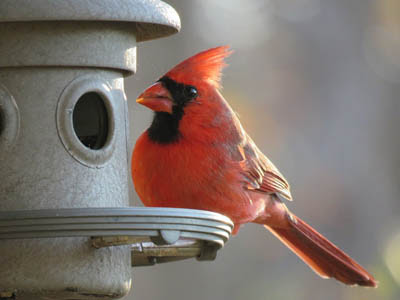 |
| Northern Cardinal. GeorgeB2 from Pixabay. |
Males of these large seed eaters are bright red with a black face and red crest.
Females replace most of the red with brown, The bill is large and orange.
These birds are found in woodlands, stream edges, residential areas.
Northern Cardinals are year-round residents throughout Oklahoma.
American Robin
These are familiar lawn birds with red breasts.
 |
| American Robin. Greg Gillson. |
Male American Robins are brownish-gray above with a brick red breast. Females are paler orange below and paler gray above.
They are widespread in open country with scattered deciduous trees, residential areas.
American Robins are year-round residents in Oklahoma.
House Finch
When people ask about a bird with a red head at their feeder, it is usually this bird.
 |
| Male House Finch. Greg Gillson. |
Males of this dusty brown striped finch have red limited to the head (specifically the forehead and eyebrow), breast (chest), and rump. The red coloration tends toward orangish, and may rarely be yellowish.
Females are streaked, similar to the males but without red. They lack any strong pattern on the face and head.
Note the small round head and curved upper ridge on the bill.
Some people call these red-headed sparrows. Sparrows and finches are similar, but in general, male finches are brighter than the females and tend to hang out more in trees. Sparrow genders are usually quite similar in coloration and tend to feed mostly on the ground.
These birds are common in residential areas, especially at bird feeders. In the West more widespread in arid regions near water.
House Finches are year-round residents in central Oklahoma, mostly absent elsewhere within the state.
Ruby-throated Hummingbird
These red-throated birds are the only hummingbird nesting in the eastern United States.

Males are dark green above and on the belly. They have a white upper chest. The throat is ruby-red.
Females are green above, white below, including white throat.
These birds are found in woodland edges, residential yards. Readily come to hummingbird feeders.
Ruby-throated Hummingbirds are summer residents in eastern Oklahoma, spring and fall migrants in western Oklahoma.
Red-headed Woodpecker
These well-known woodpeckers with red heads have a fitting name.
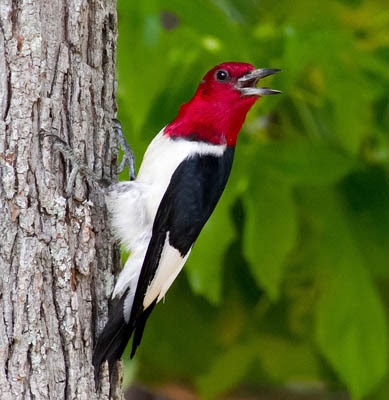 |
| Red-headed Woodpecker. Public domain. |
These birds have the entire head bright deep red. Back and tail black. Underparts white, as are inner secondaries and rump.
They are found in a variety of wooded habitats. They prefer to have oak and beech trees available. Sometimes come to feeders in winter.
Red-headed Woodpeckers are year-round residents throughout most of Oklahoma, summer residents only in the panhandle.
Summer Tanager
These bright red birds are found toward the tops of tall trees in the southern United States.

Males are rose red with fairly heavy bill.
Females are yellowish or mustard-colored, some with a faint reddish wash.
In the East these birds are found in pine-oak woodlands. In the West they prefer tall cottonwood trees.
Summer Tanagers are summer residents in eastern Oklahoma, absent in the west.
Orange birds of Oklahoma
True orange-colored birds are not that common. Many birds that I have here are paler rusty.
The common pattern is an orange body and black or brown wings and tail. Another common pattern is for the orange to be restricted to the under parts.
The following are orange birds that you are most likely to see in Oklahoma.
Barn Swallow
These orange-bellied birds are a familiar sight across North America in summer.
 |
| Barn Swallow. Greg Gillson. |
These birds are purple-blue above with orange under parts and long forked tails. The color of the underparts in winter or on females are often cinnamon or buff-colored, but breeding males can be brighter orange-red.
These birds swoop low over fields and wetlands at lower elevations. They may build their mud nests in rafters on porches, garages, or other out-buildings.
Barn Swallows are summer residents throughout Oklahoma.
Red-shouldered Hawk
Okay, the shoulders are reddish. But the rusty-orange breast and wing linings are barred red too.
 |
| Red-shouldered Hawk. Greg Gillson. |
The upper parts are barred black and white. The tail is banded black and white. In adults the breast is barred orange.
Immature birds are streaked with brown on the breast.
These birds like woodland edges, residential edges, riparian groves.
Red-shouldered Hawks are year-round residents throughout eastern Oklahoma.
American Kestrel
These are the familiar small rusty-orange falcons sitting on power lines on the edge of the highway, or hunting and hovering over the median strip.
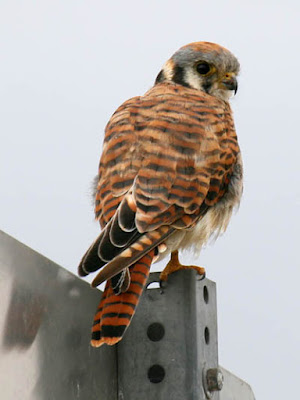 |
| Female American Kestrel. Greg Gillson. |
Females are rusty orange barred with black on their back wings and tail. The under parts are buff with black spots. The head shows two facial stripes.
Males have blue-gray backs and rufous tail is unmarked except for black tail band.
These birds are found in open country, farms, pastures with perches.
American Kestrels are year-round residents throughout Oklahoma.
Brown Thrasher
These are rather large rusty-orange songbirds.
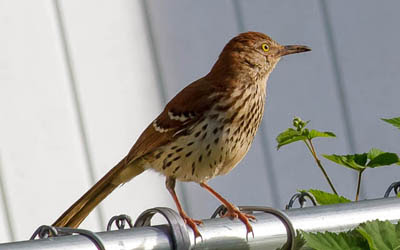 |
| Brown Thrasher. Linda Jones CC0. |
The upper parts of these birds are colored rusty-brown to orange. They show two white wing bars. Under parts are buff with heavy reddish-brown streaking.
These birds live in woodland edges and mature backyard landscaping.
Brown Thrashers are summer residents throughout Oklahoma, year-round residents in southeastern Oklahoma.
Baltimore Oriole
These bright orange and black birds are fairly common breeders in wooded areas in the East.
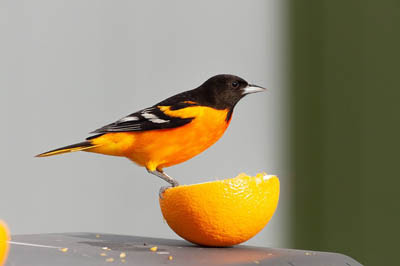 |
| Baltimore Oriole. Michael McGough. Pixabay. |
Males have a black hood and back. Wings black with white patches. Tail black with orange sides to the base. Bright orange under parts.
Females are similar to males, but more olive above, less black. Immature birds for their first year or more are olive above orangish-yellow on the breast, fading to yellow on the belly. Two white wing bars.
These birds are common in deciduous woods, shade trees.
Baltimore Orioles are summer residents throughout most of Oklahoma, spring and fall migrants only in southwestern Oklahoma and the panhandle.
Spotted Towhee
These big sparrows with red sides superficially resemble the coloration of robins.
 |
| Spotted Towhee. Greg Gillson. |
These birds have dark hoods and upper parts with rusty rufous-red sides and white bellies. They have white spots over their wings, shoulders, and on their tail corners. The upper parts of the males are jet black, females dark brown. Some populations have paler orange sides.
These are somewhat shy birds that hide in the dense brush and spend most of their time on the ground. They visit feeders during quiet periods.
Spotted Towhees are winter visitors throughout Oklahoma.
Orchard Oriole
Males of these orioles are darker rustier-orange than most other orioles in the United States.
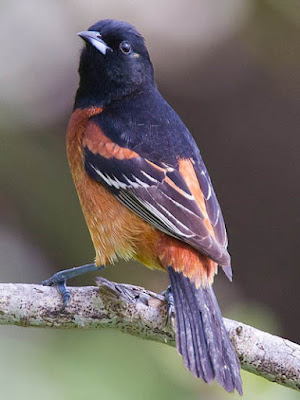 |
| Orchard Oriole. Dan Pancamo. Flikr. CC BY-SA 2.0 |
Males have a black hood and back, black wings and tail. The under parts are rusty-orange or even chestnut-brown.
Females are greenish above, lemon yellow below. They have 2 thin white wing bars. The bill is thinner than many other orioles.
They are found in orchards and residential shade trees.
Orchard Orioles are summer residents throughout Oklahoma.
Cooper’s Hawk
These crow-sized hawks with reddish orange bars on the under parts may show up in fall or winter to hunt birds at your feeder. Oh no!
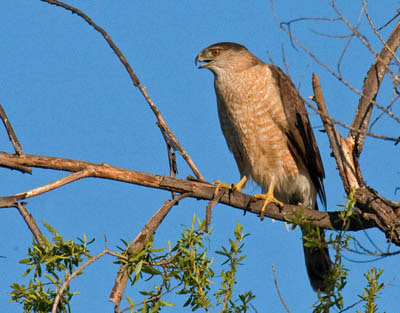 |
| Cooper’s Hawk. Greg Gillson. |
Adults with long gray and black banded tail. Dark gray above and cap on head. Under parts barred with rusty orange.
Immatures similar, brownish, streaked with brown on under parts.
Found in forests and woodlands, residential shade trees.
Cooper’s Hawks are year-round residents throughout Oklahoma.
Ruddy Duck
These small ducks are dark rusty-orange in spring.
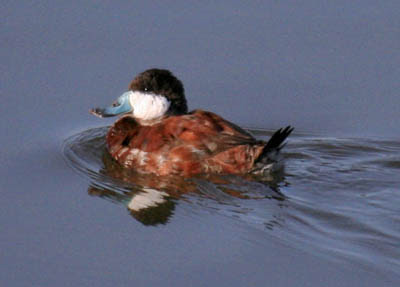 |
| Ruddy Duck. Greg Gillson. |
Males in breeding plumage (late winter and spring) are rusty, with a white face, and a blue bill. The long tail is often held sticking up. In winter they are brown, with white face, and dark bill.
Females all year are like winter males. Brown body, dark cap, dark line through eye of pale face. Dark bill.
These birds prefer weedy ponds to breed, but in winter may be found in deeper ponds in city parks.
Ruddy Ducks are spring and fall migrants throughout Oklahoma.
Yellow birds of Oklahoma
Yellow is a common bird color! Often it is mixed with black and white plumage in birds.
Many birds with darker upper parts have yellow breast or belly.
The following are yellow birds you are most likely to see in Oklahoma.
American Goldfinch
These small little birds are bright yellow and black.
 |
| American Goldfinch. Greg Gillson. |
Males are bright lemon yellow with black and white wings and tail, black cap. White under tail coverts. Pink bill.
Females are duller yellow below and brownish above. Lack black cap.
Winter birds are pale brown or gray, a touch of yellow on the throat of males.
These are birds of open country, fields with saplings, clear cuts, residential areas. They avoid dense forests, mountains, deserts. They visit feeders.
American Goldfinches are year-round residents in most of Oklahoma, winter visitors only in southwestern Oklahoma and panhandle.
Northern Flicker
These woodpeckers spend much time eating ants on the ground.
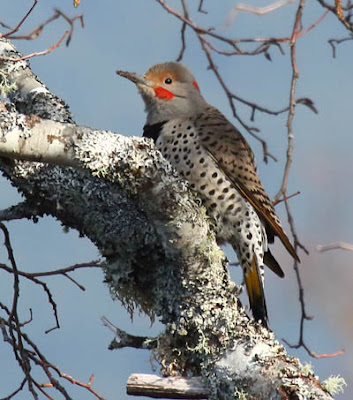 |
| Northern Flicker. Greg Gillson. |
These birds are larger than robins with brown and black barred upper parts. The underparts are pink with round black spots. There is a black crescent across the chest. When they fly away from you they reveal a large white rump.
Western birds have salmon-red under wings and under tail. Those in the East are colored yellow. The male face differs between the two populations–black whisker on the eastern birds, red whisker on western birds. Intergrades from overlap on Great Plains common. These may show male facial characteristics of both populations, or yellow-orange flight feathers.
These birds live in open woods with bare ground for foraging, residential yards.
Northern Flickers are year-round residents throughout Oklahoma.
Eastern Meadowlark
These pale brown birds with the brilliant yellow breasts are home on the ground in prairies. They sing from perches on isolated trees, power poles, fence posts.
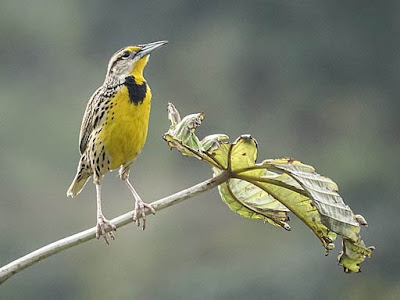 |
|
Eastern Meadowlark
Photo by Mike’s Birds from Riverside, CA, US [CC BY-SA 2.0]
|
The upper parts are streaked black, white, brown, so they blend into the dried grass where they live. The under parts are bright yellow with a black necklace across the chest. Very similar to Western Meadowlark, best told apart by spring song.
These birds live in prairies and extensive pasture lands.
Eastern Meadowlarks are year-round residents throughout most of Oklahoma, except absent in the panhandle.
Western Meadowlark
These are streaky camouflaged prairie birds from above or from behind. But from the front, the breast is shocking yellow!
 |
| Western Meadowlark. Greg Gillson. |
They are streaked brown, black, and gray on the upper parts. The underparts are golden yellow with a black necklace crossing the upper breast. Much paler yellow in fall and winter, as the yellow feathers are tipped with white and streaked with brown.
These are birds of pastures and grasslands and arid regions.
Western Meadowlarks are year-round residents in western Oklahoma, winter visitors only in eastern Oklahoma.
Yellow-rumped Warbler
These are abundant warblers across North America. Affectionately called “butter butts” by many birders, because of their bright yellow rumps that flash in flight.
 |
| Myrtle Yellow-rumped Warbler. Greg Gillson. |
Western form (Audubon’s) with bright yellow throat and yellow rump. Large white wing patch.
Northern and Eastern form (Myrtle) with white throat, yellow rump, and two white wing bars.
Winter birds are dull gray brown, with bright yellow rump. Throat may be cream colored or white. Often difficult to tell the two forms apart in winter.
 |
| Winter Yellow-rumped Warbler. Greg Gillson. |
Breed in mountain or boreal conifers. Widespread in migration. Winter in low river bottoms, open weedy deciduous areas. Rarely come to feeders in winter.
Yellow-rumped Warblers are winter visitors throughout most of Oklahoma, spring and fall migrants only in the panhandle.
Cedar Waxwing
These crested birds with yellow band on the end of the tail are often found in flocks. They eat flying insects in summer, fruit and berries the rest of the year.
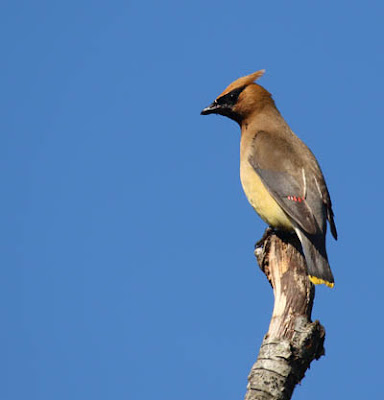 |
| Cedar Waxwing. Greg Gillson. |
These birds are fawn-brown above, with dark gray wings and tail. They have a black mask and wispy crest. The belly is yellow. The wings have waxy red drops on the end of the tertials. The end of the tail has a brilliant yellow tail band.
They are found in open habitats with berries, including juniper woodlands and towns in winter.
Cedar Waxwings are winter visitors throughout Oklahoma.
Western Kingbird
These yellow-bellied birds of the prairies often perch on power lines and fence lines.
 |
| Western Kingbird. Greg Gillson. |
These birds are pale gray on the head and breast. Brown wings. The belly is lemon yellow. Black tail has white outer tail feathers, especially obvious in flight.
These are birds of prairies, deserts, pastures, often near water.
Western Kingbirds are summer residents in western Oklahoma.
Great Crested Flycatcher
These flycatchers have long tails and big heads with big bill and bright yellow belly.
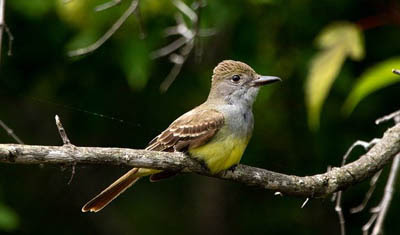 |
| Great Crested Flycatcher. Simard Francois. Pixabay. |
These birds are gray on the face and breast, brownish on rest of upper parts. Bright lemon yellow belly. The under side of the tail and some feathers of the wing are cinnamon colored.
These birds stay in the canopy of open woods.
Great Crested Flycatchers are summer residents throughout most of Oklahoma, but absent in western panhandle.
Pine Siskin
These small brown-streaked birds are relatives of the goldfinches. But you would never know it until they fly and sport yellow wing stripes and tail base. Usually in flocks.
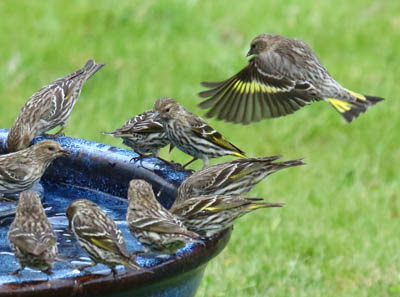 |
| Pine Siskin. Greg Gillson. |
These birds are streaked brown. In flight they have a yellow stripe down the length of the wing. The sides of the base of the tail is also yellow. Some birds are paler, some darker, others brighter yellow, others duller.
These birds are found in summer in northern conifer woods. Irregularly irrupt hundreds of miles southward. Frequent at feeders.
Pine Siskins are winter visitors throughout Oklahoma.
Dickcissel
These yellow birds often flock together in weedy roadside edges.
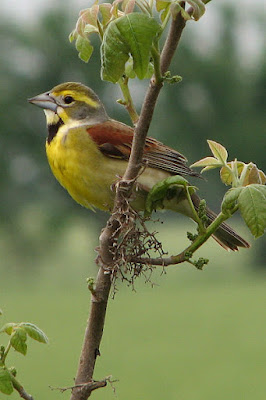 |
| Dickcissel. RebelAT. CC By-SA 3.0 |
These are gray birds with yellow breast and eyebrow.
Males have a black band across the lower throat. They have a large chestnut patch on the shoulder.
Females paler, lack black chest band.
They are found in prairie grasslands and weedy patches.
Dickcissels are summer residents throughout Oklahoma.
Yellow Warbler
The golden yellow sun packed all into one little bird! Appears to be an all-yellow bird.
 |
| Yellow Warbler. Greg Gillson. |
Some populations are bright yellow, some tend toward greenish on upper parts, some more golden. Yellow internal tail corners in flight.
Males with red breast streaking, again, variable by population.
Females somewhat to much paler yellow, some greenish, some whitish. Lack red streaks.
These birds are found in willow thickets on the edge of wetlands and ditches, stream sides in arid regions.
Yellow Warblers are summer residents throughout much of Oklahoma, spring and fall migrants only in southwestern Oklahoma.
Wrapping Up
Oklahoma’s diverse landscapes play host to a dazzling array of red, orange and yellow birds. But there are others too. Here are my pick of the state’s best blue and green beauties.
Indigo Bunting: The male’s vibrant blue body and black bib create a stunning contrast, especially in sunlight. The female is a more subtle but equally beautiful mix of brown and blue.

Little Blue Heron: These smaller herons with blue-gray plumage and dagger-like bills patiently hunt for prey in shallow wetlands. Their white throat patch and wing stripes add a touch of elegance.
Blue-headed Vireo: These olive-green songbirds with bright blue heads and white spectacles stand out in dense foliage. Listen for their loud, musical songs.
Green Heron: These stocky waders with iridescent green backs and reddish legs hunt insects and small fish in marshes and swamps. Their distinctive “squawk” call is an easy giveaway.
Yellow-throated Warbler: This energetic little bird with a bright yellow throat and olive-green upperparts adds a sunshine spark to gardens and woodlands throughout the year.
Merlin: This small falcon with slate-blue upperparts and rusty underparts is a fierce predator, often chasing smaller birds for prey.
Frequently Asked Questions
What are the red chested birds in Oklahoma?
Oklahoma boasts a few stunning bird species with red chests but the most likely is the Rose-breasted Grosbeak. This chunky songbird sports a bright rose-red chest, black head and white wing bars. Females have a streaked breast with less red, but still retain a rosy hue. Find them in woodlands, thickets, and edges.

Where can I find the Baltimore Oriole in Oklahoma?
Finding Baltimore Orioles in Oklahoma requires knowing their preferred habitat and timing your search right. Here’s what you need to know.
Look for Baltimore Orioles in open woodlands, forest edges, riparian areas (along rivers and streams), parks, and even backyards with mature trees and plenty of foliage. They particularly favor elm, oak, cottonwood, willow, maple, and apple trees, where they find insects for food and build their nests.
Baltimore Orioles are migratory birds, spending their summers in the northern parts of North America, including Oklahoma, and winters in Central and South America. They typically arrive in Oklahoma in late April or early May and depart by late September or early October.
Eastern Oklahoma is generally considered the prime Baltimore Oriole habitat in the state. Areas like the Ouachita Mountains, the Tulsa metropolitan area, and the Great Plains region offer suitable environments.
Specific locations like Sequoyah National Wildlife Refuge, Wichita Mountains Wildlife Refuge, Black Mesa State Park, and Lake Texoma State Park are known to attract Orioles.
Why are so many warbler species yellow?
The abundance of yellow in warbler species is a fascinating result of a combination of factors, including:
Coloration Mechanisms:
- Pigmentation: Yellow in warblers primarily comes from carotenoids, a type of pigment found in plants and insects that birds obtain through their diet. Carotenoids can be directly deposited in feathers, leading to vibrant yellow hues.
- Structure: Additionally, some yellow plumage can arise from the microstructure of feathers themselves. Tiny air pockets within the feathers scatter blue light, allowing only the longer yellow wavelengths to pass through and be perceived by our eyes.
Evolutionary Advantages:
- Camouflage: In some warbler species, yellow plumage can provide camouflage in leafy environments. For example, yellow warblers, with their bright yellow bodies and green streaks, blend in with foliage, especially during breeding season when they need to stay hidden from predators.
- Sexual signaling: For male warblers, yellow coloration can play a role in attracting mates. Studies have shown that brighter yellow males tend to be more successful in attracting females. This suggests that yellow feathers may signal good health and genetic fitness, making them desirable mates.
- Species recognition: For both males and females, yellow plumage can help with species recognition within flocks. Different warbler species can have specific shades of yellow or patterns that help them identify each other and maintain social cohesion.
Related Articles:
See photos and learn about the most common backyard birds in Oklahoma, regardless of color.
Here’s a quick tutorial of how I would teach you to identify birds: 7 Steps to Identify Birds!
Birds with red heads in North America.
Yellow-and-black birds in North America.









